
- Microwave Engineering - Home
- Introduction
- Transmission Lines
- Modes of Propagation
- Types of Transmission Lines
- Waveguides
- Components
- Avalanche Transit Time Devices
- Microwave Devices
- E-Plane Tee
- H-Plane Tee
- E-H Plane Tee
- Rat-race Junction
- Directional Couplers
- Cavity Klystron
- Reflex Klystron
- Travelling Wave Tube
- Magnetrons
- Measurement Devices
- Measurements
- Example Problems
Types of Transmission Lines
The conventional open-wire transmission lines are not suitable for microwave transmission, as the radiation losses would be high. At Microwave frequencies, the transmission lines employed can be broadly classified into three types. They are −
- Multi conductor lines
- Co-axial lines
- Strip lines
- Micro strip lines
- Slot lines
- Coplanar lines, etc.
- Single conductor lines (Waveguides)
- Rectangular waveguides
- Circular waveguides
- Elliptical waveguides
- Single-ridged waveguides
- Double-ridged waveguides, etc.
- Open boundary structures
- Di-electric rods
- Open waveguides, etc.
Multi-conductor Lines
The transmission lines which has more than one conductor are called as Multi-conductor lines.
Co-axial Lines
This one is mostly used for high frequency applications.
A coaxial line consists of an inner conductor with inner diameter d, and then a concentric cylindrical insulating material, around it. This is surrounded by an outer conductor, which is a concentric cylinder with an inner diameter D. This structure is well understood by taking a look at the following figure.
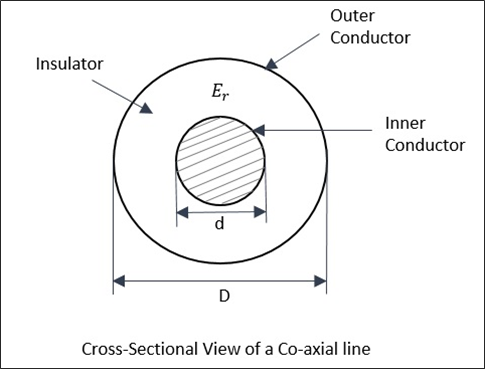
The fundamental and dominant mode in co-axial cables is TEM mode. There is no cutoff frequency in the co-axial cable. It passes all frequencies. However, for higher frequencies, some higher order non-TEM mode starts propagating, causing a lot of attenuation.
Strip Lines
These are the planar transmission lines, used at frequencies from 100MHz to 100GHz.
A Strip line consists of a central thin conducting strip of width ω which is greater than its thickness t. It is placed inside the low loss dielectric (εr) substrate of thickness b/2 between two wide ground plates. The width of the ground plates is five times greater than the spacing between the plates.
The thickness of metallic central conductor and the thickness of metallic ground planes are the same. The following figure shows the cross-sectional view of the strip line structure.
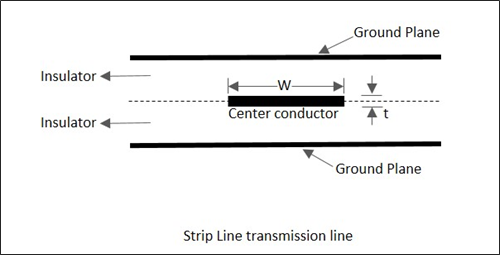
The fundamental and dominant mode in Strip lines is TEM mode. For b<λ/2, there will be no propagation in the transverse direction. The impedance of a strip line is inversely proportional to the ratio of the width ω of the inner conductor to the distance b between the ground planes.
Micro Strip Lines
The strip line has a disadvantage that it is not accessible for adjustment and tuning. This is avoided in micro strip lines, which allows mounting of active or passive devices, and also allows making minor adjustments after the circuit has been fabricated.
A micro strip line is an unsymmetrical parallel plate transmission line, having di-electric substrate which has a metallized ground on the bottom and a thin conducting strip on top with thickness 't' and width 'ω'. This can be understood by taking a look at the following figure, which shows a micro strip line.
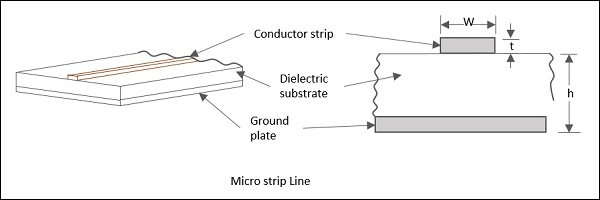
The characteristic impedance of a micro strip is a function of the strip line width (ω), thickness (t) and the distance between the line and the ground plane (h). Micro strip lines are of many types such as embedded micro strip, inverted micro strip, suspended micro strip and slotted micro strip transmission lines.
In addition to these, some other TEM lines such as parallel strip lines and coplanar strip lines also have been used for microwave integrated circuits.
Other Lines
A Parallel Strip line is similar to a two conductor transmission line. It can support quasi TEM mode. The following figure explains this.
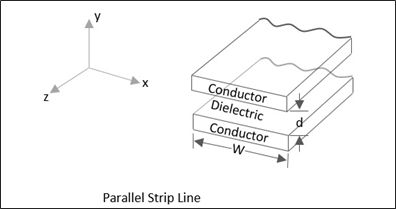
A Coplanar strip line is formed by two conducting strips with one strip grounded, both being placed on the same substrate surface, for convenient connections. The following figure explains this.
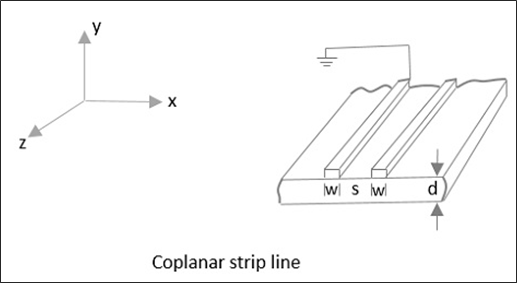
A Slot line transmission line, consists of a slot or gap in a conducting coating on a dielectric substrate and this fabrication process is identical to the micro strip lines. Following is its diagrammatical representation.
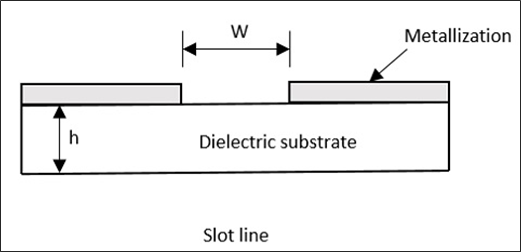
A coplanar waveguide consists of a strip of thin metallic film which is deposited on the surface of a dielectric slab. This slab has two electrodes running adjacent and parallel to the strip on to the same surface. The following figure explains this.
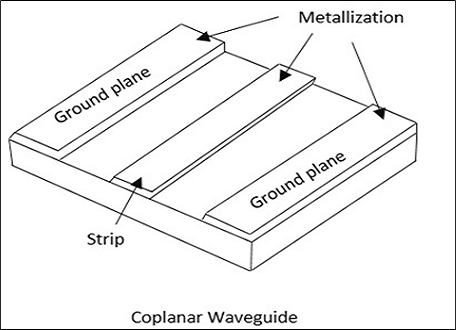
All of these micro strip lines are used in microwave applications where the use of bulky and expensive to manufacture transmission lines will be a disadvantage.
Open Boundary Structures
These can also be stated as Open Electromagnetic Waveguides. A waveguide that is not entirely enclosed in a metal shielding, can be considered as an open waveguide. Free space is also considered as a kind of open waveguide.
An open waveguide may be defined as any physical device with longitudinal axial symmetry and unbounded cross-section, capable of guiding electromagnetic waves. They possess a spectrum which is no longer discrete. Micro strip lines and optical fibers are also examples of open waveguides.